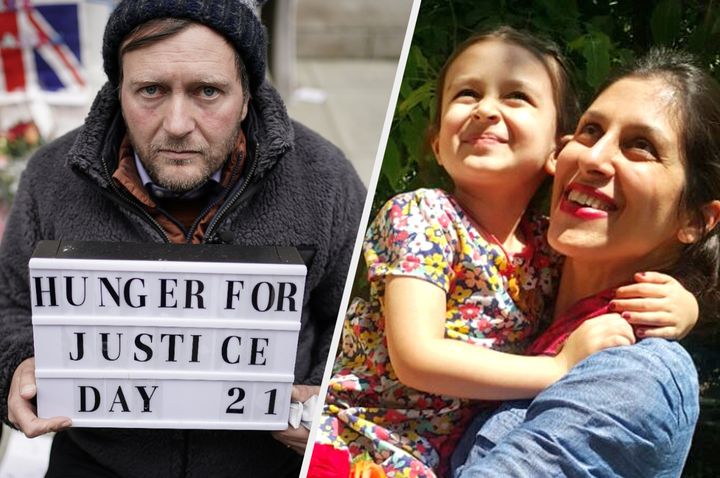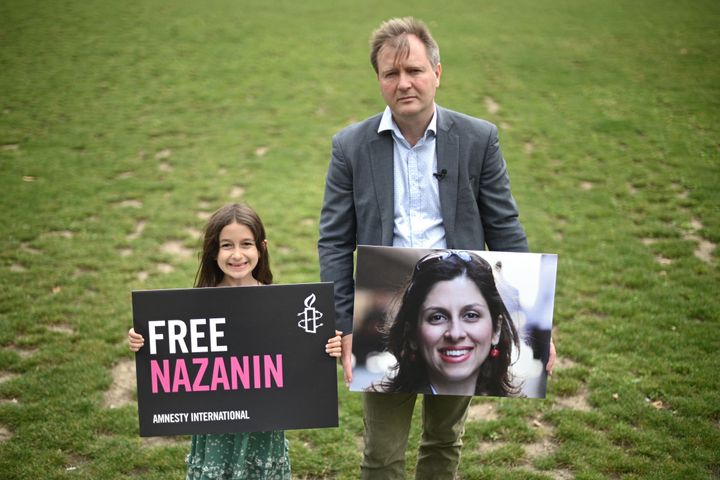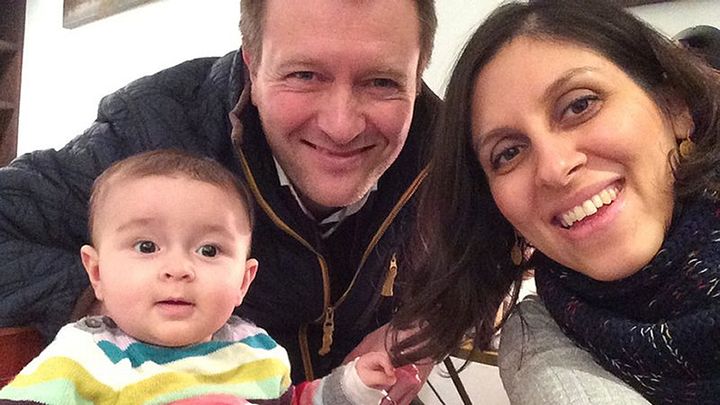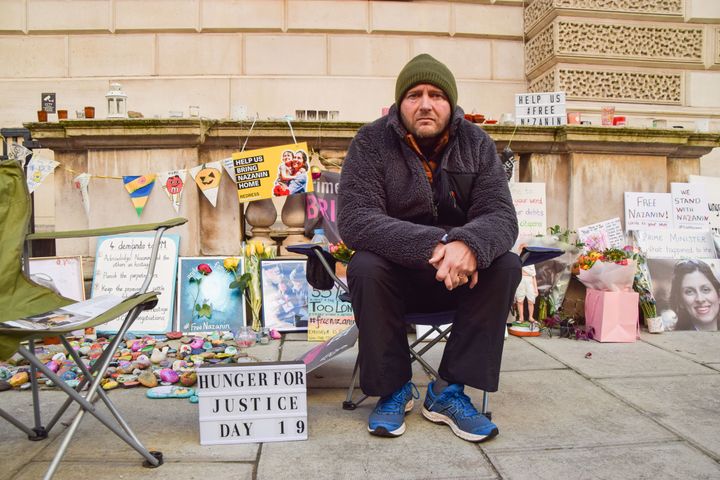
Nazanin Zaghari-Ratcliffe was finally permitted to leave Iran on Wednesday after almost six long years separated from her husband and daughter in the UK.
The British-Iranian mother has regularly made headlines since she was first arrested because of her shocking treatment, the government’s inability to secure her return to the UK earlier and the bravery of her husband Richard as he campaigned to bring her home.
Here’s the astonishing story explaining how Zaghari-Ratcliffe became a political pawn in an international game of power play.
Why was she detained in the first place?
In April 2016, the British aid worker was arrested in Iran – a place she frequently visited using her Iranian passport – as the authorities initially accused her of “plotting” against the Iranian government.
She was taking her 22-month-old daughter Gabriella on a visit to see her family at the time.
She was then detained at Tehran airport under allegations that she was a spy, and there were further claims that she had participated in recruiting and training journalists to produce propaganda against Iran for BBC Persia.
Zaghari-Ratcliffe was sentenced to five years in jail over the accusations that she wanted to topple the government. She ended up spending four years in Evin Prison and another under house arrest.
Zaghari-Ratcliffe was then sentenced to an extra year on top of a one-year travel ban.
She has denied all the charges against her ever since she was first arrested.
While detained, Zaghari-Ratcliffe was also told by the Revolutionary Guards in Iran that she was being held as a prisoner because of the UK’s failure to pay a £400 million debt from decades ago.
This debt is linked to a 1979 order for 1,500 Chieftain tanks which the UK dropped after the last king (shah) of Iran was deposed in a revolutionary movement and has been connected to the detainment of other UK-Iranian dual nationals.
So why has she been released now?
The mother-of-one was released on Wednesday after intense negotiations between the UK and Iran, where Britain finally promised to pay its debts.
The Foreign Office has been negotiating with Iran for several months, with a final agreement being reached in Muscat in February.
The UK has settled the debt by paying £393.8 million to Iran in a confidential agreement, although the money must be spent on humanitarian projects.
Zaghari-Ratcliffe had been under house arrest but was given her UK passport back earlier this week, after diplomatic efforts between the two sides over the weekend.

What happened to her while she was there?
Zaghari-Ratcliffe was not given an explanation as to why she had been arrested on her first night, and did not understand why her daughter was taken from her either.
She was interrogated and placed in solitary confinement where her quarantine cell had with no natural light, just a bulb which never went out – commonly known as a form of “white torture”.
She was only able to see her daughter Gabriella after a month, and was then able to have monthly visits with her and her mother.
Gabriella was returned to her father in the UK in 2019, and Zaghari-Ratcliffe was temporarily released in 2020 during the pandemic and went to live at her parents’ house in Tehran.
Her sentence ended in March 2021, but she then faced new charges of propaganda seven days later. She was found guilty in April, sentenced to a further year in prison.
According to her lawyer, the authorities used “scare tactics” to question Zaghari-Ratcliffe before finally handing back both her Iranian and British passports this week.

Why was the UK so slow in responding?
There have been more than 35 meetings between the prime minister, foreign office ministers and their Iranian counterparts since Zaghari-Ratcliffe and two other British nationals were imprisoned.
Over the last year, the UK has lobbied Iran more than 100 times, and a resolution seemed close over the summer of 2021, but there was no agreement reached.
Ministers seemed reluctant to associate the £400 million debt with Zaghari-Ratcliffe’s imprisonment some time.
Former foreign secretary Jeremy Hunt even claimed on Tuesday this week that the UK is a “country that pays its debts” in a conversation with LBC, but was keen to point out: “If this was a ransom demand we should not pay it.”
Then there’s the question of the international sanctions regime against Iran. There were fears that if the UK paid the debts, the funds would go to support Iranian military, just as the US is trying to pressure Iran back into its committments to hold back on its nuclear programme.
What did Truss do to help Zaghari-Ratcliffe’s release?
Truss – who became foreign secretary in September 2021 – made the release of the dual nationals her number one priority since going into the foreign office.
She reportedly encouraged her officials to find creative solutions to get it over the line.
Speaking to Times Radio on Wednesday, Labour MP Tulip Siddiq said: “When we started speaking to Liz Truss from very early on, it did seem like she was making some sort of plan to pay back the debt. And if she’s managed to make it happen, then that’s quite an achievement.”
She added: “I’ve dealt with three prime ministers and five foreign secretaries, it’s finally when I came to a woman who was foreign secretary who actually did something...
“We have such a difficult time with the other foreign secretaries speaking to them trying to convince them about this debt.
“In some ways, I would defend the government by saying they never really denied they owned Iran the money, because they went through international courts.”
Siddiq said the problem stemmed from the government “not wanting to link the fact that we owe the money and the release of Nazanin Zaghari-Ratcliffe”.
How did Boris Johnson get involved?
There have been four other foreign secretaries in government during Zaghari-Ratcliffe’s detainment in Iran, and all have come under intense criticism for failing to help the detained teacher.
But it’s Boris Johnson’s intervention which is thought to have caused the greatest difficulties.
As foreign secretary when she was first arrested, Johnson infamously said Zaghari-Ratcliffe was in Tehran to train journalists, despite her team’s defence claiming she was there on holiday.
The now-prime minister said: “When we look at what Nazanin Zaghari-Ratcliffe was doing, she was simply teaching people journalism, as I understand it, at the very limit.”
These remarks were said to put her in greater danger, as they were cited as evidence against her due her time in the Iranian court.
He also promised that he had found a way to pay the debt – but nothing was concrete by the time he made his announcement.
What did her husband do?
Richard Ratcliffe has been a pivotal part of his wife’s story. He went against the Foreign Office advice and went public about her ordeal, meaning her story has arguably become more famous than the other detainee being released on Wednesday (Anousheh Ashouri).
Ratcliffe also discovered that her imprisonment was connected to an unpaid £400 million debt during his campaign to bring his wife home, and that the Islamic Revolutionary Guards Corps’ were known to take hostages.
He and his wife launched an online petition in 2016 asking for the prime minister and Iran’s supreme leader to secure both Gabriella and her mother’s return to the UK – it racked up a whopping 3.5 million supporters from around the globe.
He has repeatedly put pressure on the foreign secretaries to act over the last six years, and went on hunger strike in November last year in a bid to get the government’s assistance.
Just last Friday he he wrote a legal letter to Truss asking for the Foreign Office to describe her as a state hostage, not a detainee. He claimed his wife had become collateral in the bargain over what the US would do to lift its sanctions against Iran over the 2015 nuclear programme for Iran.

